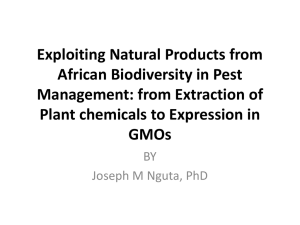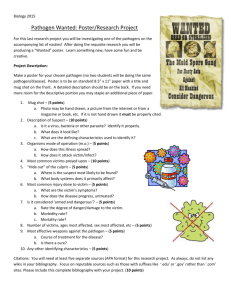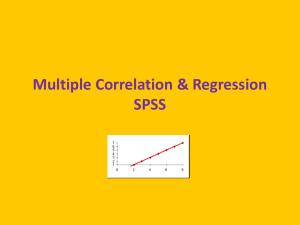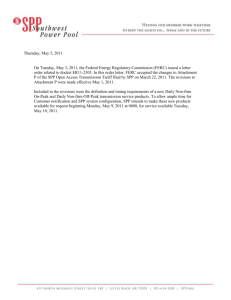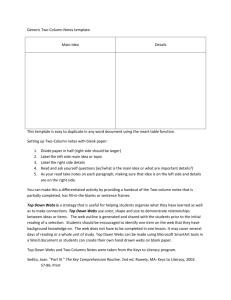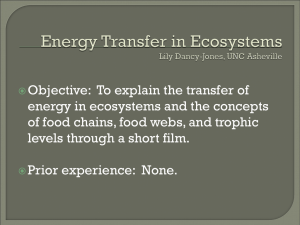ece31647-sup-0003-AppendixS2
advertisement
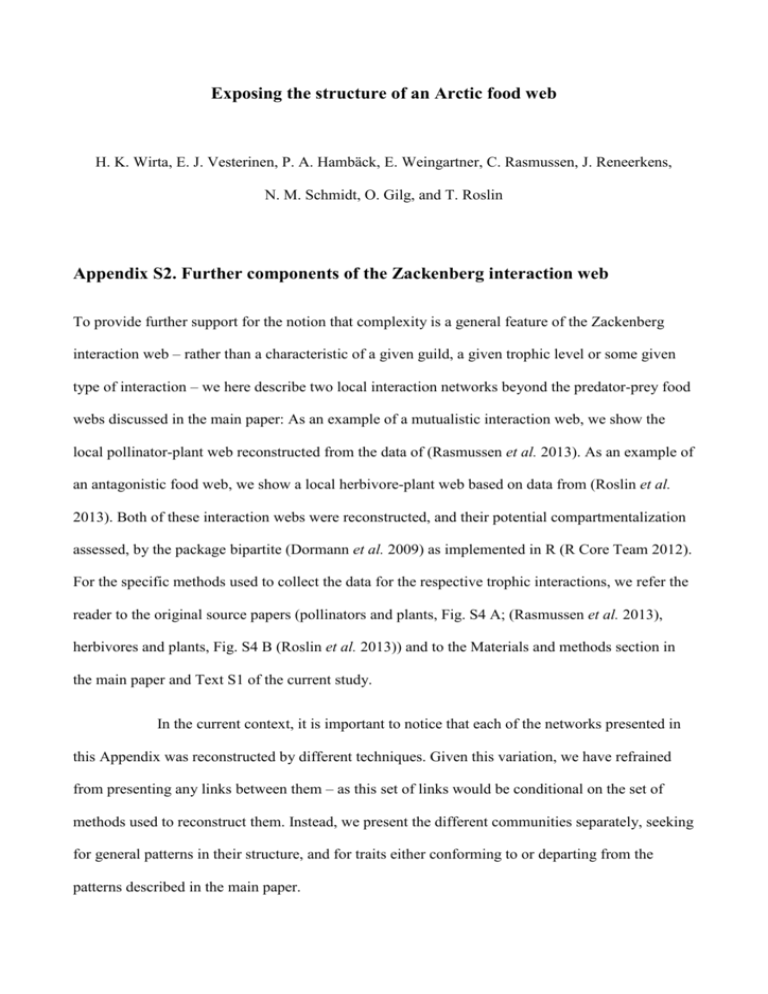
Exposing the structure of an Arctic food web H. K. Wirta, E. J. Vesterinen, P. A. Hambäck, E. Weingartner, C. Rasmussen, J. Reneerkens, N. M. Schmidt, O. Gilg, and T. Roslin Appendix S2. Further components of the Zackenberg interaction web To provide further support for the notion that complexity is a general feature of the Zackenberg interaction web – rather than a characteristic of a given guild, a given trophic level or some given type of interaction – we here describe two local interaction networks beyond the predator-prey food webs discussed in the main paper: As an example of a mutualistic interaction web, we show the local pollinator-plant web reconstructed from the data of (Rasmussen et al. 2013). As an example of an antagonistic food web, we show a local herbivore-plant web based on data from (Roslin et al. 2013). Both of these interaction webs were reconstructed, and their potential compartmentalization assessed, by the package bipartite (Dormann et al. 2009) as implemented in R (R Core Team 2012). For the specific methods used to collect the data for the respective trophic interactions, we refer the reader to the original source papers (pollinators and plants, Fig. S4 A; (Rasmussen et al. 2013), herbivores and plants, Fig. S4 B (Roslin et al. 2013)) and to the Materials and methods section in the main paper and Text S1 of the current study. In the current context, it is important to notice that each of the networks presented in this Appendix was reconstructed by different techniques. Given this variation, we have refrained from presenting any links between them – as this set of links would be conditional on the set of methods used to reconstruct them. Instead, we present the different communities separately, seeking for general patterns in their structure, and for traits either conforming to or departing from the patterns described in the main paper. As main findings, both the mutualistic and the antagonistic interaction webs among plants and arthropods (Fig. S4 A and B) show a densely-linked structure. Moreover, they both consist of a single compartment, implying that each species in the web is connected to all other species through shared pollinators, herbivores and/or host plants. In all of these features, they match the predator-prey webs described in the main text. Overall, we believe that these representations all show joint support for the notion that our target web is characterized by dense links – across biotic interactions of many kinds. What our study does not adequately resolve are the links between interactions of different types. It is well evident that the trophic food web of predator-prey interactions (cf. main paper) is intricately linked with the other types of interaction webs presented in this Appendix. Of the prey taxa targeted in the main paper, Diptera form the main pollinators in this community (Elberling & Olesen 1999; Rasmussen et al. 2013), and Lepidoptera are pollinators as adults but herbivores as larvae (Roslin et al. 2013). Linking the separate modules into a regional interaction ‘metaweb’ (cf. Pocock, Evans & Memmott 2012) is thus our ultimate objective, and the subject of ongoing work. Figure S4. Local interaction webs for supplementary interaction types at Zackenberg: A) pollinators and the plants that they visit (Rasmussen et al. 2013) and B) lepidopteran herbivores and the plants that they consume (Roslin et al. 2013). The species are numbered as in the table S3 below. Table S2. Plant, pollinator and herbivore species forming the mutualistic interaction web of pollinators and plants in Fig S4 A (Rasmussen et al. 2013) and the antagonistic food web of lepidopteran herbivores and plants in Fig S4 B (Roslin et al. 2013). # Plant species # Pollinator/ herbivore order family species Diptera SI-1 SI-2 SI-3 SI-4 SI-5 SI-6 SI-7 SI-8 SI-9 SI-10 SI-11 SI-12 SI-13 SI-14 SI-15 SI-16 SI-17 SI-18 SI-19 SI-20 SI-21 SI-22 SI-23 Arenaria pseudofrigida Armeria scabra Arnica angustifolia Betula nana Cardamine pratensis Cassiope tetragona Cerastium arcticum Chamaenerion latifolium Cochlearia groenlandica Draba arctica Draba lactea Draba spp. Dryas octopetala Erigeron compositus Eriophorium triste Lesquerella arctica Melandrium triflorum Papaver radicatum Pedicularis flammea Pedicularis hirsuta Polygonum viviparum Potentilla hyparctica Potentilla rubricaulis SI-44 SI-45 SI-46 SI-47 SI-48 SI-49 SI-50 SI-51 SI-52 SI-53 SI-54 SI-55 SI-56 SI-57 SI-58 SI-59 SI-60 SI-61 SI-62 SI-63 SI-64 SI-65 SI-66 SI-24 SI-25 SI-26 SI-27 Pyrola grandiflora Ranunculus hyperboreus Ranunculus pygmaeus Ranunculus sulphureus Rhododendron lapponicum Salix arctica Saxifraga caespitosa Saxifraga cernua Saxifraga hirculus Saxifraga hyperborea Saxifraga nivalis Saxifraga oppositifolia Saxifraga rivularis Silene acaulis Stellaria humifusa Stellaria longipes Taraxacum arcticum Taraxacum phymatocarpum Vaccinium uliginosum grass SI-67 SI-68 SI-69 SI-70 Phytomyza fuscula Delia echinata Fucellia pictipennis Paradelia arctica Pegomya icterica Zaphne divisa Zaphne frontata Zaphne occidentalis Zaphne tundrica Cynomya mortuorum Brachypogon spp. Culicoides sp. Chironomus hyperboreus Cricotopus magus Cricotopus spp. Limnophyes asquamatus Limnophyes brachytomus Limnophyes cf. natalensis Limnophyes cf. ninae Limnophyes ninae Limnophyes spp. Metriocnemus spp. Orthocladius spp. Paraphaenocladius impensus Procladius paragretis Psectrocladius limbatellus Pseudosmittia cf. nanseni SI-71 SI-72 SI-73 SI-74 SI-75 SI-76 SI-77 SI-78 SI-79 SI-80 SI-81 SI-82 SI-83 Pseudosmittia nanseni Pseudosmittia spp. Rheocricotopus chapmani Smittia sp. 17 Smittia sp. 2 Smittia sp. aff. edwardsi Smittia sp. x Smittia sp. y Smittia spp. Tanytarsus sp. 1 Aedes impiger Aedes nigripes Rhamphomyia filicauda SI-28 SI-29 SI-30 SI-31 SI-32 SI-33 SI-34 SI-35 SI-36 SI-37 SI-38 SI-39 SI-40 SI-41 SI-42 SI-43 SI-84 SI-85 SI-86 SI-87 Agromyzidae Anthomyiidae Calliphoridae Ceratopogonidae Chironomidae Culicidae Empididae Muscidae Rhamphomyia nigrita Drymeia groenlandica Drymeia segnis Limnophora groenlandica SI-88 SI-89 SI-90 SI-91 SI-92 SI-93 SI-94 SI-95 SI-96 SI-97 SI-98 SI-99 SI-100 SI-101 SI-102 SI-103 SI-104 SI-105 SI-106 SI-107 SI-108 SI-109 SI-110 SI-111 SI-112 SI-113 SI-114 SI-115 SI-116 SI-117 SI-118 SI-119 Hemiptera SI-120 Hymenoptera SI-121 SI-122 SI-123 SI-124 SI-125 SI-126 SI-127 SI-128 SI-129 SI-130 SI-131 SI-132 SI-133 Phoridae Piophilidae Scathophagidae Sciaridae Syrphidae Tachinidae Lygaeidae Ichneumonidae Braconidae Lophosceles minimus Phaonia bidentata Spilogona almqvistii Spilogona arcticola Spilogona deflorata Spilogona denudata Spilogona dorsata Spilogona malaisei Spilogona megastoma Spilogona micans Spilogona obsoleta Spilogona sanctipauli Spilogona tendipes Spilogona tornensis Spilogona zaitzevi Megaselia arcticae Lasiopiophila pilosa Gonarcticus arcticus Scathophaga furcata Scathophaga nigripalpis Bradysia spp. Lycoriella sp. 1 Eupeodes punctifer Eupeodes rufipunctatus Helophilus groenlandicus Helophilus lapponicus Parasyrphus tarsatus Platycheirus carinatus Platycheirus lundbecki Syrphus torvus Peleteria aenea Nysius groenlandicus Atractodes alpestris Atractodes aterrimus Atractodes sp. 1 Buathra laborator Gelis maesticolor Gelis sp. 1 Neurateles sp. 1 Picrostigeus sp. 1 Plectiscus sp. 1 Plectiscus sp. 2 Stenomacrus sp. 2 Stenomacrus micropennis Stenomacrus sp. 1 Cotesia hallii SI-134 SI-135 SI-136 SI-137 SI-138 SI-139 SI-140 SI-141 SI-142 Lepidoptera SI-143 SI-144 SI-145 SI-146 SI-147 SI-148 SI-149 SI-150 SI-151 SI-152 SI-153 SI-154 SI-155 Apidae Encyrtidae Eulophidae Pteromalidae Geometridae Erebidae Lycaenidae Noctuidae Nymphalidae Pieridae Pyralidae Tortricidae Dacnusa groenlandica Praon brevistigma Protapanteles fulvipes Bombus hyperboreus Bombus polaris Pseudencyrtus sp. 1 Aprostocetus meltoftei Pachyneuron groenlandicum Entephria punctipes Entephria sp. Gynaephora groenlandica Plebeius glandon Apamea zeta Euxoa adumbrata drewseni Polia richardsoni Sympistis zetterstedtii Syngrapha parilis Boloria chariclea Boloria spp. Colias hecla Pyla fusca Olethreutes mengelana References for Text S2 Dormann, C.F., Fründ, J., Blüthgen, N. & Gruber, B. (2009) Indices, graphs and null models: Analyzing bipartite ecological networks. The Open Ecology Journal, 2, 7-24. Elberling, H. & Olesen, J.M. (1999) The structure of a high latitude plant-flowe visitor system: the dominance of flies. Ecography, 22, 314-323. Pocock, M.J.O., Evans, D.M. & Memmott, J. (2012) The robustness and restoration of a network of ecological networks. Science, 335, 973-977. R, C.T. (2012) R: a language and environment for statistical computing. Vienna, Austria. Rasmussen, C., Dupont, Y.L., Mosbacher, J.B., Trøjelsgaard, K. & Olesen, J.M. (2013) Strong Impact of Temporal Resolution on the Structure of an Ecological Network. PLoS ONE, 8, e81694. Roslin, T., Wirta, H., Hopkins, T., Hardwick, B. & Várkonyi, G. (2013) Indirect interactions in the High Arctic. PLoS ONE, 8, e67367.



